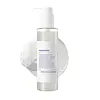What's inside
What's inside
 Key Ingredients
Key Ingredients

No key ingredients
 Benefits
Benefits

 Concerns
Concerns

 Ingredients Side-by-side
Ingredients Side-by-side

Water
Skin ConditioningGlycerin
HumectantCoco-Betaine
CleansingLauryl Glucoside
CleansingPolyglyceryl-4 Caprate
Emulsifying1,2-Hexanediol
Skin ConditioningSodium Cocoyl Isethionate
CleansingSodium Chloride
MaskingArginine
MaskingAcrylates/C10-30 Alkyl Acrylate Crosspolymer
Emulsion StabilisingXanthan Gum
EmulsifyingBoswellia Carterii Oil
MaskingButylene Glycol
HumectantPropanediol
SolventGlycosyl Trehalose
Emulsion StabilisingHydrogenated Starch Hydrolysate
HumectantMacadamia Ternifolia Seed Oil
EmollientFructan
Skin ConditioningRubus Fruticosus Fruit Extract
AstringentVaccinium Macrocarpon Fruit Extract
AstringentVaccinium Angustifolium Fruit Extract
Skin ProtectingRubus Idaeus Fruit Extract
AstringentSambucus Nigra Fruit Extract
AstringentWater, Glycerin, Coco-Betaine, Lauryl Glucoside, Polyglyceryl-4 Caprate, 1,2-Hexanediol, Sodium Cocoyl Isethionate, Sodium Chloride, Arginine, Acrylates/C10-30 Alkyl Acrylate Crosspolymer, Xanthan Gum, Boswellia Carterii Oil, Butylene Glycol, Propanediol, Glycosyl Trehalose, Hydrogenated Starch Hydrolysate, Macadamia Ternifolia Seed Oil, Fructan, Rubus Fruticosus Fruit Extract, Vaccinium Macrocarpon Fruit Extract, Vaccinium Angustifolium Fruit Extract, Rubus Idaeus Fruit Extract, Sambucus Nigra Fruit Extract
Water
Skin ConditioningGlycerin
HumectantCoco-Betaine
CleansingMethyl Gluceth-20
HumectantDipropylene Glycol
HumectantCentella Asiatica Leaf Water
Skin ConditioningSodium Chloride
MaskingXanthan Gum
EmulsifyingPanthenol
Skin ConditioningMethylpropanediol
SolventSodium Cocoyl Isethionate
Cleansing1,2-Hexanediol
Skin ConditioningSodium Benzoate
MaskingAcrylates/C10-30 Alkyl Acrylate Crosspolymer
Emulsion StabilisingTromethamine
BufferingButylene Glycol
HumectantCentella Asiatica Extract
CleansingAsiaticoside
AntioxidantAsiatic Acid
Skin ConditioningMadecassoside
AntioxidantMadecassic Acid
Skin ConditioningEthylhexylglycerin
Skin ConditioningCaramel
Cosmetic ColorantDisodium EDTA
Water, Glycerin, Coco-Betaine, Methyl Gluceth-20, Dipropylene Glycol, Centella Asiatica Leaf Water, Sodium Chloride, Xanthan Gum, Panthenol, Methylpropanediol, Sodium Cocoyl Isethionate, 1,2-Hexanediol, Sodium Benzoate, Acrylates/C10-30 Alkyl Acrylate Crosspolymer, Tromethamine, Butylene Glycol, Centella Asiatica Extract, Asiaticoside, Asiatic Acid, Madecassoside, Madecassic Acid, Ethylhexylglycerin, Caramel, Disodium EDTA
 Reviews
Reviews

Ingredients Explained
These ingredients are found in both products.
Ingredients higher up in an ingredient list are typically present in a larger amount.
1,2-Hexanediol is a synthetic liquid and another multi-functional powerhouse.
It is a:
- Humectant, drawing moisture into the skin
- Emollient, helping to soften skin
- Solvent, dispersing and stabilizing formulas
- Preservative booster, enhancing the antimicrobial activity of other preservatives
Acrylates/C10-30 Alkyl Acrylate Crosspolymer is a synthetic polymer. It is used to thicken and improve the texture of products. Due to its properties, it can prevent water and oil ingredients from separating.
Butylene Glycol (or BG) is used within cosmetic products for a few different reasons:
Overall, Butylene Glycol is a safe and well-rounded ingredient that works well with other ingredients.
Though this ingredient works well with most skin types, some people with sensitive skin may experience a reaction such as allergic rashes, closed comedones, or itchiness.
Learn more about Butylene GlycolCoco-Betaine is the natural version of Cocamidopropyl Betaine. It is often derived from coconuts.
Coco-Betaine is a surfactant, meaning it helps remove dirt and oil from the skin.
Glycerin is already naturally found in your skin. It helps moisturize and protect your skin.
A study from 2016 found glycerin to be more effective as a humectant than AHAs and hyaluronic acid.
As a humectant, it helps the skin stay hydrated by pulling moisture to your skin. The low molecular weight of glycerin allows it to pull moisture into the deeper layers of your skin.
Hydrated skin improves your skin barrier; Your skin barrier helps protect against irritants and bacteria.
Glycerin has also been found to have antimicrobial and antiviral properties. Due to these properties, glycerin is often used in wound and burn treatments.
In cosmetics, glycerin is usually derived from plants such as soybean or palm. However, it can also be sourced from animals, such as tallow or animal fat.
This ingredient is organic, colorless, odorless, and non-toxic.
Glycerin is the name for this ingredient in American English. British English uses Glycerol/Glycerine.
Learn more about GlycerinChances are, you eat sodium chloride every day. Sodium Chloride is also known as table salt.
This ingredient has many purposes in skincare: thickener, emulsifier, and exfoliator.
You'll most likely find this ingredient in cleansers where it is used to create a gel-like texture. As an emulsifier, it also prevents ingredients from separating.
There is much debate on whether this ingredient is comedogenic. The short answer - comedogenic ratings don't tell the whole story. Learn more about comegodenic ratings here.
The concensus about this ingredient causing acne seems to be divided. Research is needed to understand if this ingredient does cause acne.
Scrubs may use salt as the primary exfoliating ingredient.
Learn more about Sodium ChlorideSodium cocoyl isethionate is a natural ingredient from coconut oil. It is an ultra gentle cleanser that gives a nice foam without drying the skin or impacting the skin barrier.
The amount of foam created depends on the amount of sodium cocoyl isethionate used in the product.
This ingredient also helps improve the spreadability of a product.
Learn more about Sodium Cocoyl IsethionateWater. It's the most common cosmetic ingredient of all. You'll usually see it at the top of ingredient lists, meaning that it makes up the largest part of the product.
So why is it so popular? Water most often acts as a solvent - this means that it helps dissolve other ingredients into the formulation.
You'll also recognize water as that liquid we all need to stay alive. If you see this, drink a glass of water. Stay hydrated!
Learn more about WaterXanthan gum is used as a stabilizer and thickener within cosmetic products. It helps give products a sticky, thick feeling - preventing them from being too runny.
On the technical side of things, xanthan gum is a polysaccharide - a combination consisting of multiple sugar molecules bonded together.
Xanthan gum is a pretty common and great ingredient. It is a natural, non-toxic, non-irritating ingredient that is also commonly used in food products.
Learn more about Xanthan Gum